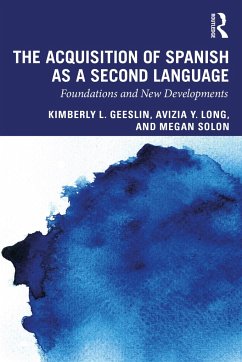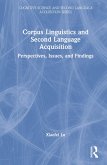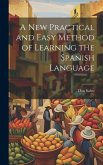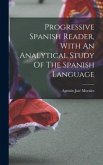Kimberly L. Geeslin, Avizia Y. Long, Megan Solon
The Acquisition of Spanish as a Second Language
Foundations and New Developments
Kimberly L. Geeslin, Avizia Y. Long, Megan Solon
The Acquisition of Spanish as a Second Language
Foundations and New Developments
- Broschiertes Buch
- Merkliste
- Auf die Merkliste
- Bewerten Bewerten
- Teilen
- Produkt teilen
- Produkterinnerung
- Produkterinnerung
This volume offers an introduction to the field of second language acquisition with a particular focus on second language Spanish. It connects key issues in the acquisition of Spanish as a second language to theoretical and empirical issues in the field of second language acquisition more generally by exemplifying central concepts in second language acquisition through the exploration of the most widely researched structures and most recent developments in the field of second language Spanish. It is written for a non-specialist audience, making it suitable for advanced undergraduate and…mehr
Andere Kunden interessierten sich auch für
![The Acquisition of French as a Second Language The Acquisition of French as a Second Language]() The Acquisition of French as a Second Language81,99 €
The Acquisition of French as a Second Language81,99 €![MYP Spanish Language Acquisition (Emergent) Print and Enhanced Online Course Book Pack MYP Spanish Language Acquisition (Emergent) Print and Enhanced Online Course Book Pack]() Cristobal Gonzalez SalgadoMYP Spanish Language Acquisition (Emergent) Print and Enhanced Online Course Book Pack69,99 €
Cristobal Gonzalez SalgadoMYP Spanish Language Acquisition (Emergent) Print and Enhanced Online Course Book Pack69,99 €![Corpus Linguistics and Second Language Acquisition Corpus Linguistics and Second Language Acquisition]() Xiaofei LuCorpus Linguistics and Second Language Acquisition180,99 €
Xiaofei LuCorpus Linguistics and Second Language Acquisition180,99 €![Exploring the Spanish Language Exploring the Spanish Language]() Christopher J. PountainExploring the Spanish Language60,99 €
Christopher J. PountainExploring the Spanish Language60,99 €![Critical Influences on Child Language Acquisition and Development Critical Influences on Child Language Acquisition and Development]() David J MesserCritical Influences on Child Language Acquisition and Development199,99 €
David J MesserCritical Influences on Child Language Acquisition and Development199,99 €![A New Practical and Easy Method of Learning the Spanish Language A New Practical and Easy Method of Learning the Spanish Language]() Don SalvoA New Practical and Easy Method of Learning the Spanish Language37,99 €
Don SalvoA New Practical and Easy Method of Learning the Spanish Language37,99 €![Progressive Spanish Reader, With An Analytical Study Of The Spanish Language Progressive Spanish Reader, With An Analytical Study Of The Spanish Language]() Agustin José MoralesProgressive Spanish Reader, With An Analytical Study Of The Spanish Language39,99 €
Agustin José MoralesProgressive Spanish Reader, With An Analytical Study Of The Spanish Language39,99 €-
-
-
This volume offers an introduction to the field of second language acquisition with a particular focus on second language Spanish. It connects key issues in the acquisition of Spanish as a second language to theoretical and empirical issues in the field of second language acquisition more generally by exemplifying central concepts in second language acquisition through the exploration of the most widely researched structures and most recent developments in the field of second language Spanish. It is written for a non-specialist audience, making it suitable for advanced undergraduate and graduate courses and readers, while its treatment of recent empirical developments also makes it of interest to researchers in second language Spanish as well as allied fields.
Hinweis: Dieser Artikel kann nur an eine deutsche Lieferadresse ausgeliefert werden.
Hinweis: Dieser Artikel kann nur an eine deutsche Lieferadresse ausgeliefert werden.
Produktdetails
- Produktdetails
- Verlag: Routledge
- Seitenzahl: 428
- Erscheinungstermin: 23. April 2021
- Englisch
- Abmessung: 229mm x 152mm x 23mm
- Gewicht: 616g
- ISBN-13: 9781138920354
- ISBN-10: 1138920355
- Artikelnr.: 59999746
- Herstellerkennzeichnung
- Books on Demand GmbH
- In de Tarpen 42
- 22848 Norderstedt
- info@bod.de
- 040 53433511
- Verlag: Routledge
- Seitenzahl: 428
- Erscheinungstermin: 23. April 2021
- Englisch
- Abmessung: 229mm x 152mm x 23mm
- Gewicht: 616g
- ISBN-13: 9781138920354
- ISBN-10: 1138920355
- Artikelnr.: 59999746
- Herstellerkennzeichnung
- Books on Demand GmbH
- In de Tarpen 42
- 22848 Norderstedt
- info@bod.de
- 040 53433511
Kimberly L. Geeslin is Professor of Hispanic Linguistics in the Department of Spanish and Portuguese at Indiana University, USA. Her research focuses on second language Spanish and the intersection of second language acquisition and sociolinguistics. Avizia Y. Long is Assistant Professor of Spanish in the Department of World Languages and Literatures at San José State University, USA. Her research interests include the acquisition of sociolinguistic variation by non-Western learners, study abroad and the acquisition of second language Spanish phonetics and phonology, and the role of the instructor in classroom-based learning. Megan Solon is Assistant Research Scientist in the Department of Applied Health Science at Indiana University, USA. Her research focuses on the acquisition of phonetics and phonology in second and heritage language Spanish and explores the acquisition of variable phonetic features as well as the role of learning context and instructional practices on phonetic development.
Contents
PART I: Fundamentals of Research on the Acquisition of Spanish as a Second
Language
Chapter One: Introduction to Perspectives on Second Language Acquisition
1. Introduction
2. The Study of Second Language Acquisition
1. What is a Second Language Learner?
2. How are Second Languages Different from Additional (Third, Fourth,
Fifth, etc.) Languages?
3. Why is Second Language Spanish Important?
4. What does It Mean to "Know" a Language?
1. Historical perspectives
1. Cognitive Approaches to Second Language Acquisition
2. The Relationship of Social and Linguistic Factors to Language
Acquisition
1. Key Developments in the Field of Second Language Acquisition
1. Common Paths of Development
2. Influence of the First Language
3. Importance of Input
4. Influence of Linguistic Factors, Learner Characteristics, and Social
Context
1. The Contributions of Technology in Advancing Research on Second
Language Acquisition
2. Summary: Critical Considerations in Assessing Research in Second
Language Acquisition
3. Conclusion
4. Note
5. Reading beyond the Text
6. Comprehension
Chapter Two: Research Methods
1. Introduction
2. What Is Linguistic Data?
1. How Do We Characterize Linguistic Data?
2. What Types of Linguistic Data Do Second Language Researchers Use?
1. How Do We Get Linguistic Data?
1. Eliciting Production Data
1. Oral interviews
1. Prompt-based writing
1. Picture description or narration
1. Other types of guided production
1. Highly-controlled production
1. Interaction-based elicitation
1. Eliciting Judgement and Interpretation Data
1. Psycholinguistic Measures
1. What Do We Do with Linguistic Data?
2. Non-Linguistic Data
3. Conclusion
4. Notes
5. Reading beyond the Text
6. Comprehension
PART II. Central Issues in Second Language Acquisition and Case Studies of
Spanish
Chapter Three: First Language Influence and the Acquisition of /b d g/
1. Introduction
2. The Role of First Languages in Second Language Acquisition
1. What is Cross-Linguistic Influence?
2. Historical Perspectives: The 1950's
3. Historical Perspectives: Generative Grammar
4. Current Research Goals and Perspectives
1. Test Case from Spanish: The Acquisition of /b d g/
1. /b d g/ in Spanish
2. The Challenge for English-speaking Learners of Spanish
1. Research on /b d g/ in Second Language Spanish
1. Stages of Development of /b d g/
2. The Role of Instruction and Study Abroad
1. Connections
1. Additional Spanish Sounds
2. Connections beyond the Sound System
1. Conclusion
2. Reading beyond the Text
3. Comprehension
Chapter Four: Developmental Paths and the Acquisition of Copula Contrast
1. Introduction
2. Universal Patterns in the Path to Acquisition of a Second Language
1. Early Work: Morpheme Acquisition Studies
2. Explaining the Order of Acquisition
3. Criticism of the Morpheme Acquisition Studies
1. Test Case from Spanish: The Acquisition of Ser and Estar
1. The Copula Contrast in Spanish
2. Challenges for English-Speaking Learners of Spanish
1. Research on the Acquisition of Ser and Estar
1. Stages of Development of Copula Acquisition
2. Additional Learners and Learning Contexts
3. Stages within the [Copula + Adjective] Context
1. Connections
1. Additional Structures: Spanish Number and Gender
2. Connections to the Field of Second Language Acquisition
1. Conclusion
2. Notes
3. Reading beyond the Text
4. Comprehension
Chapter Five: Form-Meaning Mapping and the Acquisition of Past-Time Marking
1. Introduction
2. Form-Meaning Mapping
1. What is Form-Meaning Mapping?
2. Universal Strategies
3. Variation as Hypothesis Testing
1. Test Case from Spanish: The Acquisition of Preterit and Imperfect
1. The Preterit and Imperfect in Spanish
2. Challenges for English-speaking Learners of Spanish
1. Research on the Acquisition of the Preterit and Imperfect
1. Lexical Aspect in Preterit/Imperfect Form-Meaning Mapping
2. Additional Factors Affecting the Acquisition of the Preterit and
Imperfect
3. Acquisition of the Preterit and Imperfect by Advanced Second Language
Learners
1. Connections
1. Additional Structures: Spanish Subjunctive
2. Connections to the Field of Second Language Acquisition
1. Conclusion
2. Notes
3. Reading beyond the Text
4. Comprehension
Chapter Six: Input, Language Variation, and the Acquisition of Object
Pronouns
1. Introduction
2. Input and Second Language Acquisition
1. Linguistic Variation and Second Language Acquisition
1. Test Case from Spanish: Object Pronouns
1. Object Pronouns in Spanish
2. Challenges for English-Speaking Learners of Spanish
1. Research on the Acquisition of Object Pronouns
1. Early Research and the First Noun Strategy
2. The Challenge of the Third Person Singular Object Pronoun: Le versus
Lo
3. The Role of Geography
1. Connections
1. Additional Variable Structures: The Expression of Future Time
Reference
2. Additional Variable Structures: Forms of Address
3. Connections to the Field of SLA
1. Conclusion
2. Reading beyond the Text
3. Comprehension
PART III: Expansion and Application
Chapter Seven: Study Abroad and the Acquisition of Variable /s/-weakening
1. Introduction
2. The Role of Study Abroad in Second Language Acquisition
1. The Influence of Study Abroad on Proficiency
2. Communicative Competence and Study Abroad
3. Study Abroad and Spanish Phonology
4. Study Abroad and Spanish Morphosyntax
5. Study Abroad and Spanish Pragmatics
6. The Role of Extralinguistic Factors in Mediating the Benefits of
Study Abroad
7. The Role of Instruction in Mediating the Benefits of Study Abroad
8. Characteristics of the Study Abroad Context
9. Characteristics of the Learner
1. Test Case from Spanish: /s/-weakening
1. /s/-weakening in Spanish
2. Challenges for English-Speaking Learners of Spanish
1. Research on the Acquisition of /s/-weakening
1. Research on Production
2. Research on Perception
1. Connections
1. Additional Structures: The Interdental Fricative [¿]
2. Additional Structures: Variable Morphosyntax
3. Connections to the Field of SLA
1. Conclusion
2. Reading beyond the Text
3. Comprehension
Chapter Eight: Insights for the Classroom and the Acquisition of Subject
Forms
1. Introduction
2. Instruction of Second Language Spanish
1. Insights from Second Language Acquisition that Drive Good Pedagogy
2. Recent Developments in Second Language Instruction
3. The Role of Instructor Characteristics in Language Instruction
4. Research on Task-based Instruction
5. The Pan-Dialectal Nature of Classroom Input
1. Test Case from Spanish: Subject Forms in Learner-Directed Language
1. Subject Forms in Spanish
2. Challenges for English-Speaking Learners of Spanish
1. Research on the Acquisition of Subject Forms
1. Patterns in the Second Language Acquisition of Subject Forms
2. Research on Written and Oral Learner-Directed Language
3. Implications for Acquisition of Subject Forms in Instructed Settings
1. Connections
1. Additional Structures: Preterit and Imperfect
2. Connections to the Field of SLA
i. The role of input and interaction
ii. How can language instruction foster second language acquisition?
iii. Connecting research with practice
iv. Use tasks to facilitate learning through meaningful communication
v. Consider task design features thoughtfully when planning lessons,
courses, and curricula
vi. Vary interactional partners
vii. Seek and provide numerous and varied sources of input
viii. Consider individual differences
ix. Use technology thoughtfully to encourage real online interaction
1. Conclusion
2. Notes
3. Reading beyond the Text
4. Comprehension
PART I: Fundamentals of Research on the Acquisition of Spanish as a Second
Language
Chapter One: Introduction to Perspectives on Second Language Acquisition
1. Introduction
2. The Study of Second Language Acquisition
1. What is a Second Language Learner?
2. How are Second Languages Different from Additional (Third, Fourth,
Fifth, etc.) Languages?
3. Why is Second Language Spanish Important?
4. What does It Mean to "Know" a Language?
1. Historical perspectives
1. Cognitive Approaches to Second Language Acquisition
2. The Relationship of Social and Linguistic Factors to Language
Acquisition
1. Key Developments in the Field of Second Language Acquisition
1. Common Paths of Development
2. Influence of the First Language
3. Importance of Input
4. Influence of Linguistic Factors, Learner Characteristics, and Social
Context
1. The Contributions of Technology in Advancing Research on Second
Language Acquisition
2. Summary: Critical Considerations in Assessing Research in Second
Language Acquisition
3. Conclusion
4. Note
5. Reading beyond the Text
6. Comprehension
Chapter Two: Research Methods
1. Introduction
2. What Is Linguistic Data?
1. How Do We Characterize Linguistic Data?
2. What Types of Linguistic Data Do Second Language Researchers Use?
1. How Do We Get Linguistic Data?
1. Eliciting Production Data
1. Oral interviews
1. Prompt-based writing
1. Picture description or narration
1. Other types of guided production
1. Highly-controlled production
1. Interaction-based elicitation
1. Eliciting Judgement and Interpretation Data
1. Psycholinguistic Measures
1. What Do We Do with Linguistic Data?
2. Non-Linguistic Data
3. Conclusion
4. Notes
5. Reading beyond the Text
6. Comprehension
PART II. Central Issues in Second Language Acquisition and Case Studies of
Spanish
Chapter Three: First Language Influence and the Acquisition of /b d g/
1. Introduction
2. The Role of First Languages in Second Language Acquisition
1. What is Cross-Linguistic Influence?
2. Historical Perspectives: The 1950's
3. Historical Perspectives: Generative Grammar
4. Current Research Goals and Perspectives
1. Test Case from Spanish: The Acquisition of /b d g/
1. /b d g/ in Spanish
2. The Challenge for English-speaking Learners of Spanish
1. Research on /b d g/ in Second Language Spanish
1. Stages of Development of /b d g/
2. The Role of Instruction and Study Abroad
1. Connections
1. Additional Spanish Sounds
2. Connections beyond the Sound System
1. Conclusion
2. Reading beyond the Text
3. Comprehension
Chapter Four: Developmental Paths and the Acquisition of Copula Contrast
1. Introduction
2. Universal Patterns in the Path to Acquisition of a Second Language
1. Early Work: Morpheme Acquisition Studies
2. Explaining the Order of Acquisition
3. Criticism of the Morpheme Acquisition Studies
1. Test Case from Spanish: The Acquisition of Ser and Estar
1. The Copula Contrast in Spanish
2. Challenges for English-Speaking Learners of Spanish
1. Research on the Acquisition of Ser and Estar
1. Stages of Development of Copula Acquisition
2. Additional Learners and Learning Contexts
3. Stages within the [Copula + Adjective] Context
1. Connections
1. Additional Structures: Spanish Number and Gender
2. Connections to the Field of Second Language Acquisition
1. Conclusion
2. Notes
3. Reading beyond the Text
4. Comprehension
Chapter Five: Form-Meaning Mapping and the Acquisition of Past-Time Marking
1. Introduction
2. Form-Meaning Mapping
1. What is Form-Meaning Mapping?
2. Universal Strategies
3. Variation as Hypothesis Testing
1. Test Case from Spanish: The Acquisition of Preterit and Imperfect
1. The Preterit and Imperfect in Spanish
2. Challenges for English-speaking Learners of Spanish
1. Research on the Acquisition of the Preterit and Imperfect
1. Lexical Aspect in Preterit/Imperfect Form-Meaning Mapping
2. Additional Factors Affecting the Acquisition of the Preterit and
Imperfect
3. Acquisition of the Preterit and Imperfect by Advanced Second Language
Learners
1. Connections
1. Additional Structures: Spanish Subjunctive
2. Connections to the Field of Second Language Acquisition
1. Conclusion
2. Notes
3. Reading beyond the Text
4. Comprehension
Chapter Six: Input, Language Variation, and the Acquisition of Object
Pronouns
1. Introduction
2. Input and Second Language Acquisition
1. Linguistic Variation and Second Language Acquisition
1. Test Case from Spanish: Object Pronouns
1. Object Pronouns in Spanish
2. Challenges for English-Speaking Learners of Spanish
1. Research on the Acquisition of Object Pronouns
1. Early Research and the First Noun Strategy
2. The Challenge of the Third Person Singular Object Pronoun: Le versus
Lo
3. The Role of Geography
1. Connections
1. Additional Variable Structures: The Expression of Future Time
Reference
2. Additional Variable Structures: Forms of Address
3. Connections to the Field of SLA
1. Conclusion
2. Reading beyond the Text
3. Comprehension
PART III: Expansion and Application
Chapter Seven: Study Abroad and the Acquisition of Variable /s/-weakening
1. Introduction
2. The Role of Study Abroad in Second Language Acquisition
1. The Influence of Study Abroad on Proficiency
2. Communicative Competence and Study Abroad
3. Study Abroad and Spanish Phonology
4. Study Abroad and Spanish Morphosyntax
5. Study Abroad and Spanish Pragmatics
6. The Role of Extralinguistic Factors in Mediating the Benefits of
Study Abroad
7. The Role of Instruction in Mediating the Benefits of Study Abroad
8. Characteristics of the Study Abroad Context
9. Characteristics of the Learner
1. Test Case from Spanish: /s/-weakening
1. /s/-weakening in Spanish
2. Challenges for English-Speaking Learners of Spanish
1. Research on the Acquisition of /s/-weakening
1. Research on Production
2. Research on Perception
1. Connections
1. Additional Structures: The Interdental Fricative [¿]
2. Additional Structures: Variable Morphosyntax
3. Connections to the Field of SLA
1. Conclusion
2. Reading beyond the Text
3. Comprehension
Chapter Eight: Insights for the Classroom and the Acquisition of Subject
Forms
1. Introduction
2. Instruction of Second Language Spanish
1. Insights from Second Language Acquisition that Drive Good Pedagogy
2. Recent Developments in Second Language Instruction
3. The Role of Instructor Characteristics in Language Instruction
4. Research on Task-based Instruction
5. The Pan-Dialectal Nature of Classroom Input
1. Test Case from Spanish: Subject Forms in Learner-Directed Language
1. Subject Forms in Spanish
2. Challenges for English-Speaking Learners of Spanish
1. Research on the Acquisition of Subject Forms
1. Patterns in the Second Language Acquisition of Subject Forms
2. Research on Written and Oral Learner-Directed Language
3. Implications for Acquisition of Subject Forms in Instructed Settings
1. Connections
1. Additional Structures: Preterit and Imperfect
2. Connections to the Field of SLA
i. The role of input and interaction
ii. How can language instruction foster second language acquisition?
iii. Connecting research with practice
iv. Use tasks to facilitate learning through meaningful communication
v. Consider task design features thoughtfully when planning lessons,
courses, and curricula
vi. Vary interactional partners
vii. Seek and provide numerous and varied sources of input
viii. Consider individual differences
ix. Use technology thoughtfully to encourage real online interaction
1. Conclusion
2. Notes
3. Reading beyond the Text
4. Comprehension
Contents
PART I: Fundamentals of Research on the Acquisition of Spanish as a Second
Language
Chapter One: Introduction to Perspectives on Second Language Acquisition
1. Introduction
2. The Study of Second Language Acquisition
1. What is a Second Language Learner?
2. How are Second Languages Different from Additional (Third, Fourth,
Fifth, etc.) Languages?
3. Why is Second Language Spanish Important?
4. What does It Mean to "Know" a Language?
1. Historical perspectives
1. Cognitive Approaches to Second Language Acquisition
2. The Relationship of Social and Linguistic Factors to Language
Acquisition
1. Key Developments in the Field of Second Language Acquisition
1. Common Paths of Development
2. Influence of the First Language
3. Importance of Input
4. Influence of Linguistic Factors, Learner Characteristics, and Social
Context
1. The Contributions of Technology in Advancing Research on Second
Language Acquisition
2. Summary: Critical Considerations in Assessing Research in Second
Language Acquisition
3. Conclusion
4. Note
5. Reading beyond the Text
6. Comprehension
Chapter Two: Research Methods
1. Introduction
2. What Is Linguistic Data?
1. How Do We Characterize Linguistic Data?
2. What Types of Linguistic Data Do Second Language Researchers Use?
1. How Do We Get Linguistic Data?
1. Eliciting Production Data
1. Oral interviews
1. Prompt-based writing
1. Picture description or narration
1. Other types of guided production
1. Highly-controlled production
1. Interaction-based elicitation
1. Eliciting Judgement and Interpretation Data
1. Psycholinguistic Measures
1. What Do We Do with Linguistic Data?
2. Non-Linguistic Data
3. Conclusion
4. Notes
5. Reading beyond the Text
6. Comprehension
PART II. Central Issues in Second Language Acquisition and Case Studies of
Spanish
Chapter Three: First Language Influence and the Acquisition of /b d g/
1. Introduction
2. The Role of First Languages in Second Language Acquisition
1. What is Cross-Linguistic Influence?
2. Historical Perspectives: The 1950's
3. Historical Perspectives: Generative Grammar
4. Current Research Goals and Perspectives
1. Test Case from Spanish: The Acquisition of /b d g/
1. /b d g/ in Spanish
2. The Challenge for English-speaking Learners of Spanish
1. Research on /b d g/ in Second Language Spanish
1. Stages of Development of /b d g/
2. The Role of Instruction and Study Abroad
1. Connections
1. Additional Spanish Sounds
2. Connections beyond the Sound System
1. Conclusion
2. Reading beyond the Text
3. Comprehension
Chapter Four: Developmental Paths and the Acquisition of Copula Contrast
1. Introduction
2. Universal Patterns in the Path to Acquisition of a Second Language
1. Early Work: Morpheme Acquisition Studies
2. Explaining the Order of Acquisition
3. Criticism of the Morpheme Acquisition Studies
1. Test Case from Spanish: The Acquisition of Ser and Estar
1. The Copula Contrast in Spanish
2. Challenges for English-Speaking Learners of Spanish
1. Research on the Acquisition of Ser and Estar
1. Stages of Development of Copula Acquisition
2. Additional Learners and Learning Contexts
3. Stages within the [Copula + Adjective] Context
1. Connections
1. Additional Structures: Spanish Number and Gender
2. Connections to the Field of Second Language Acquisition
1. Conclusion
2. Notes
3. Reading beyond the Text
4. Comprehension
Chapter Five: Form-Meaning Mapping and the Acquisition of Past-Time Marking
1. Introduction
2. Form-Meaning Mapping
1. What is Form-Meaning Mapping?
2. Universal Strategies
3. Variation as Hypothesis Testing
1. Test Case from Spanish: The Acquisition of Preterit and Imperfect
1. The Preterit and Imperfect in Spanish
2. Challenges for English-speaking Learners of Spanish
1. Research on the Acquisition of the Preterit and Imperfect
1. Lexical Aspect in Preterit/Imperfect Form-Meaning Mapping
2. Additional Factors Affecting the Acquisition of the Preterit and
Imperfect
3. Acquisition of the Preterit and Imperfect by Advanced Second Language
Learners
1. Connections
1. Additional Structures: Spanish Subjunctive
2. Connections to the Field of Second Language Acquisition
1. Conclusion
2. Notes
3. Reading beyond the Text
4. Comprehension
Chapter Six: Input, Language Variation, and the Acquisition of Object
Pronouns
1. Introduction
2. Input and Second Language Acquisition
1. Linguistic Variation and Second Language Acquisition
1. Test Case from Spanish: Object Pronouns
1. Object Pronouns in Spanish
2. Challenges for English-Speaking Learners of Spanish
1. Research on the Acquisition of Object Pronouns
1. Early Research and the First Noun Strategy
2. The Challenge of the Third Person Singular Object Pronoun: Le versus
Lo
3. The Role of Geography
1. Connections
1. Additional Variable Structures: The Expression of Future Time
Reference
2. Additional Variable Structures: Forms of Address
3. Connections to the Field of SLA
1. Conclusion
2. Reading beyond the Text
3. Comprehension
PART III: Expansion and Application
Chapter Seven: Study Abroad and the Acquisition of Variable /s/-weakening
1. Introduction
2. The Role of Study Abroad in Second Language Acquisition
1. The Influence of Study Abroad on Proficiency
2. Communicative Competence and Study Abroad
3. Study Abroad and Spanish Phonology
4. Study Abroad and Spanish Morphosyntax
5. Study Abroad and Spanish Pragmatics
6. The Role of Extralinguistic Factors in Mediating the Benefits of
Study Abroad
7. The Role of Instruction in Mediating the Benefits of Study Abroad
8. Characteristics of the Study Abroad Context
9. Characteristics of the Learner
1. Test Case from Spanish: /s/-weakening
1. /s/-weakening in Spanish
2. Challenges for English-Speaking Learners of Spanish
1. Research on the Acquisition of /s/-weakening
1. Research on Production
2. Research on Perception
1. Connections
1. Additional Structures: The Interdental Fricative [¿]
2. Additional Structures: Variable Morphosyntax
3. Connections to the Field of SLA
1. Conclusion
2. Reading beyond the Text
3. Comprehension
Chapter Eight: Insights for the Classroom and the Acquisition of Subject
Forms
1. Introduction
2. Instruction of Second Language Spanish
1. Insights from Second Language Acquisition that Drive Good Pedagogy
2. Recent Developments in Second Language Instruction
3. The Role of Instructor Characteristics in Language Instruction
4. Research on Task-based Instruction
5. The Pan-Dialectal Nature of Classroom Input
1. Test Case from Spanish: Subject Forms in Learner-Directed Language
1. Subject Forms in Spanish
2. Challenges for English-Speaking Learners of Spanish
1. Research on the Acquisition of Subject Forms
1. Patterns in the Second Language Acquisition of Subject Forms
2. Research on Written and Oral Learner-Directed Language
3. Implications for Acquisition of Subject Forms in Instructed Settings
1. Connections
1. Additional Structures: Preterit and Imperfect
2. Connections to the Field of SLA
i. The role of input and interaction
ii. How can language instruction foster second language acquisition?
iii. Connecting research with practice
iv. Use tasks to facilitate learning through meaningful communication
v. Consider task design features thoughtfully when planning lessons,
courses, and curricula
vi. Vary interactional partners
vii. Seek and provide numerous and varied sources of input
viii. Consider individual differences
ix. Use technology thoughtfully to encourage real online interaction
1. Conclusion
2. Notes
3. Reading beyond the Text
4. Comprehension
PART I: Fundamentals of Research on the Acquisition of Spanish as a Second
Language
Chapter One: Introduction to Perspectives on Second Language Acquisition
1. Introduction
2. The Study of Second Language Acquisition
1. What is a Second Language Learner?
2. How are Second Languages Different from Additional (Third, Fourth,
Fifth, etc.) Languages?
3. Why is Second Language Spanish Important?
4. What does It Mean to "Know" a Language?
1. Historical perspectives
1. Cognitive Approaches to Second Language Acquisition
2. The Relationship of Social and Linguistic Factors to Language
Acquisition
1. Key Developments in the Field of Second Language Acquisition
1. Common Paths of Development
2. Influence of the First Language
3. Importance of Input
4. Influence of Linguistic Factors, Learner Characteristics, and Social
Context
1. The Contributions of Technology in Advancing Research on Second
Language Acquisition
2. Summary: Critical Considerations in Assessing Research in Second
Language Acquisition
3. Conclusion
4. Note
5. Reading beyond the Text
6. Comprehension
Chapter Two: Research Methods
1. Introduction
2. What Is Linguistic Data?
1. How Do We Characterize Linguistic Data?
2. What Types of Linguistic Data Do Second Language Researchers Use?
1. How Do We Get Linguistic Data?
1. Eliciting Production Data
1. Oral interviews
1. Prompt-based writing
1. Picture description or narration
1. Other types of guided production
1. Highly-controlled production
1. Interaction-based elicitation
1. Eliciting Judgement and Interpretation Data
1. Psycholinguistic Measures
1. What Do We Do with Linguistic Data?
2. Non-Linguistic Data
3. Conclusion
4. Notes
5. Reading beyond the Text
6. Comprehension
PART II. Central Issues in Second Language Acquisition and Case Studies of
Spanish
Chapter Three: First Language Influence and the Acquisition of /b d g/
1. Introduction
2. The Role of First Languages in Second Language Acquisition
1. What is Cross-Linguistic Influence?
2. Historical Perspectives: The 1950's
3. Historical Perspectives: Generative Grammar
4. Current Research Goals and Perspectives
1. Test Case from Spanish: The Acquisition of /b d g/
1. /b d g/ in Spanish
2. The Challenge for English-speaking Learners of Spanish
1. Research on /b d g/ in Second Language Spanish
1. Stages of Development of /b d g/
2. The Role of Instruction and Study Abroad
1. Connections
1. Additional Spanish Sounds
2. Connections beyond the Sound System
1. Conclusion
2. Reading beyond the Text
3. Comprehension
Chapter Four: Developmental Paths and the Acquisition of Copula Contrast
1. Introduction
2. Universal Patterns in the Path to Acquisition of a Second Language
1. Early Work: Morpheme Acquisition Studies
2. Explaining the Order of Acquisition
3. Criticism of the Morpheme Acquisition Studies
1. Test Case from Spanish: The Acquisition of Ser and Estar
1. The Copula Contrast in Spanish
2. Challenges for English-Speaking Learners of Spanish
1. Research on the Acquisition of Ser and Estar
1. Stages of Development of Copula Acquisition
2. Additional Learners and Learning Contexts
3. Stages within the [Copula + Adjective] Context
1. Connections
1. Additional Structures: Spanish Number and Gender
2. Connections to the Field of Second Language Acquisition
1. Conclusion
2. Notes
3. Reading beyond the Text
4. Comprehension
Chapter Five: Form-Meaning Mapping and the Acquisition of Past-Time Marking
1. Introduction
2. Form-Meaning Mapping
1. What is Form-Meaning Mapping?
2. Universal Strategies
3. Variation as Hypothesis Testing
1. Test Case from Spanish: The Acquisition of Preterit and Imperfect
1. The Preterit and Imperfect in Spanish
2. Challenges for English-speaking Learners of Spanish
1. Research on the Acquisition of the Preterit and Imperfect
1. Lexical Aspect in Preterit/Imperfect Form-Meaning Mapping
2. Additional Factors Affecting the Acquisition of the Preterit and
Imperfect
3. Acquisition of the Preterit and Imperfect by Advanced Second Language
Learners
1. Connections
1. Additional Structures: Spanish Subjunctive
2. Connections to the Field of Second Language Acquisition
1. Conclusion
2. Notes
3. Reading beyond the Text
4. Comprehension
Chapter Six: Input, Language Variation, and the Acquisition of Object
Pronouns
1. Introduction
2. Input and Second Language Acquisition
1. Linguistic Variation and Second Language Acquisition
1. Test Case from Spanish: Object Pronouns
1. Object Pronouns in Spanish
2. Challenges for English-Speaking Learners of Spanish
1. Research on the Acquisition of Object Pronouns
1. Early Research and the First Noun Strategy
2. The Challenge of the Third Person Singular Object Pronoun: Le versus
Lo
3. The Role of Geography
1. Connections
1. Additional Variable Structures: The Expression of Future Time
Reference
2. Additional Variable Structures: Forms of Address
3. Connections to the Field of SLA
1. Conclusion
2. Reading beyond the Text
3. Comprehension
PART III: Expansion and Application
Chapter Seven: Study Abroad and the Acquisition of Variable /s/-weakening
1. Introduction
2. The Role of Study Abroad in Second Language Acquisition
1. The Influence of Study Abroad on Proficiency
2. Communicative Competence and Study Abroad
3. Study Abroad and Spanish Phonology
4. Study Abroad and Spanish Morphosyntax
5. Study Abroad and Spanish Pragmatics
6. The Role of Extralinguistic Factors in Mediating the Benefits of
Study Abroad
7. The Role of Instruction in Mediating the Benefits of Study Abroad
8. Characteristics of the Study Abroad Context
9. Characteristics of the Learner
1. Test Case from Spanish: /s/-weakening
1. /s/-weakening in Spanish
2. Challenges for English-Speaking Learners of Spanish
1. Research on the Acquisition of /s/-weakening
1. Research on Production
2. Research on Perception
1. Connections
1. Additional Structures: The Interdental Fricative [¿]
2. Additional Structures: Variable Morphosyntax
3. Connections to the Field of SLA
1. Conclusion
2. Reading beyond the Text
3. Comprehension
Chapter Eight: Insights for the Classroom and the Acquisition of Subject
Forms
1. Introduction
2. Instruction of Second Language Spanish
1. Insights from Second Language Acquisition that Drive Good Pedagogy
2. Recent Developments in Second Language Instruction
3. The Role of Instructor Characteristics in Language Instruction
4. Research on Task-based Instruction
5. The Pan-Dialectal Nature of Classroom Input
1. Test Case from Spanish: Subject Forms in Learner-Directed Language
1. Subject Forms in Spanish
2. Challenges for English-Speaking Learners of Spanish
1. Research on the Acquisition of Subject Forms
1. Patterns in the Second Language Acquisition of Subject Forms
2. Research on Written and Oral Learner-Directed Language
3. Implications for Acquisition of Subject Forms in Instructed Settings
1. Connections
1. Additional Structures: Preterit and Imperfect
2. Connections to the Field of SLA
i. The role of input and interaction
ii. How can language instruction foster second language acquisition?
iii. Connecting research with practice
iv. Use tasks to facilitate learning through meaningful communication
v. Consider task design features thoughtfully when planning lessons,
courses, and curricula
vi. Vary interactional partners
vii. Seek and provide numerous and varied sources of input
viii. Consider individual differences
ix. Use technology thoughtfully to encourage real online interaction
1. Conclusion
2. Notes
3. Reading beyond the Text
4. Comprehension








